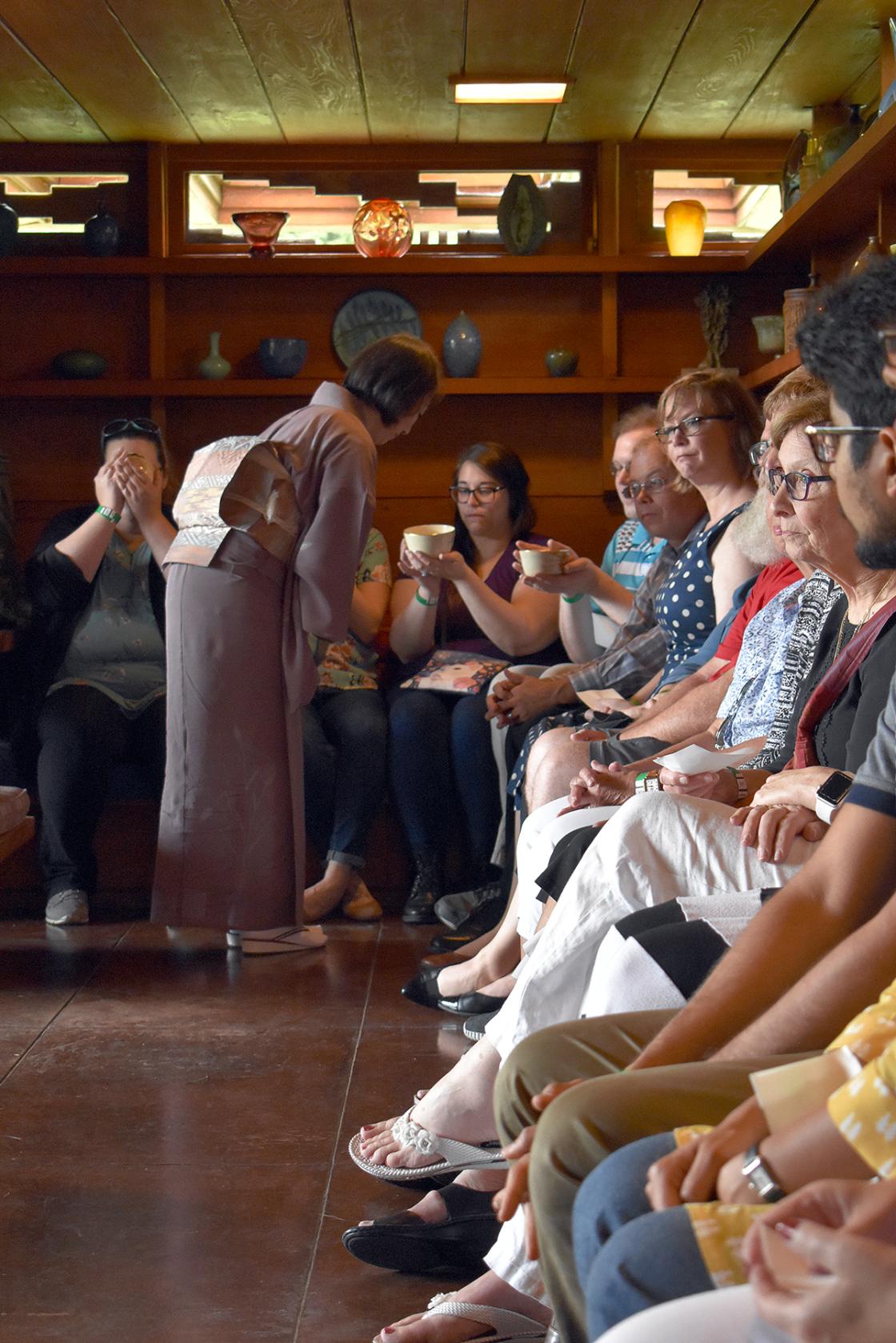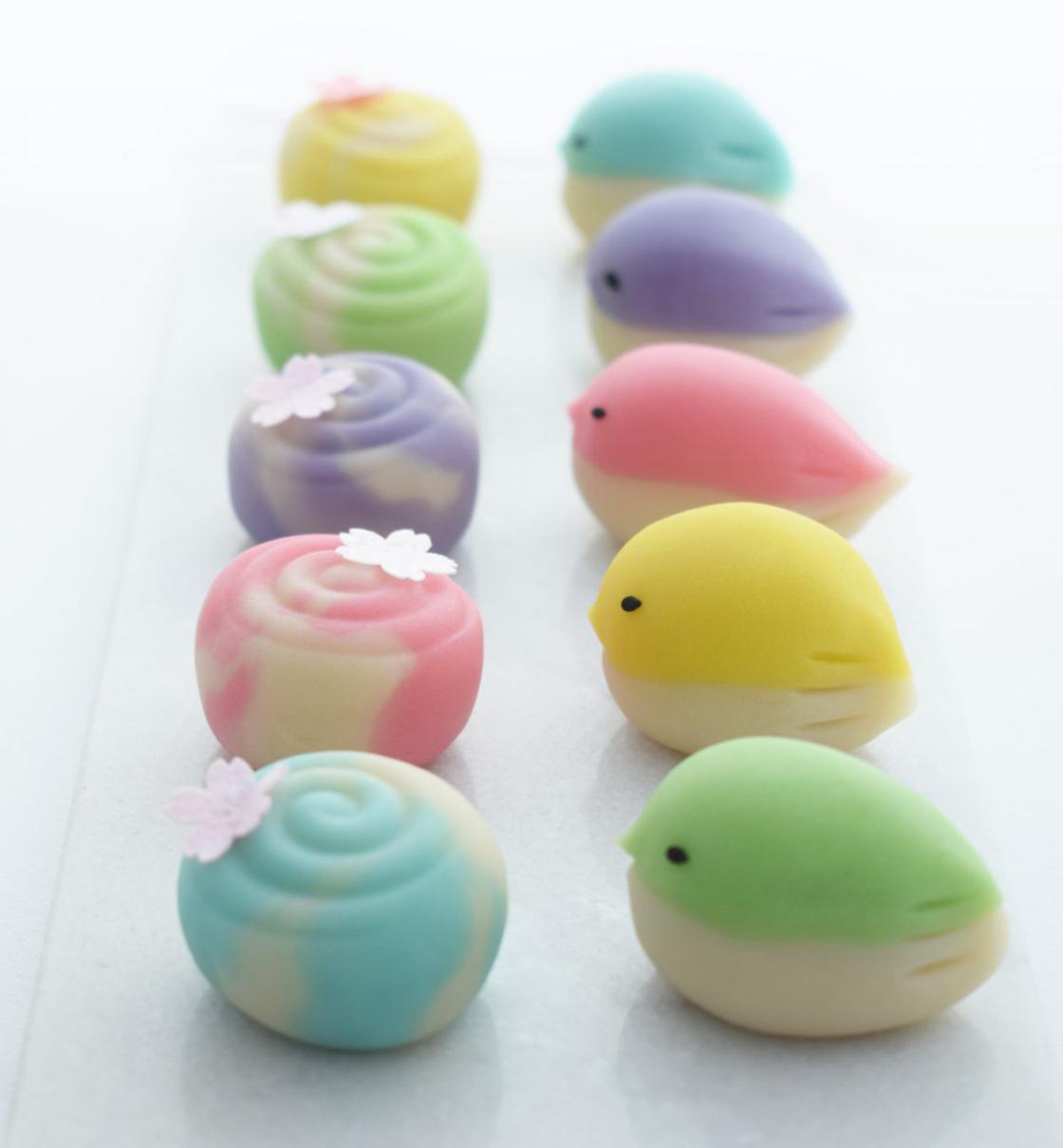和菓子 | 生け花 | 書道 | 茶の湯
WAGASHI, IKEBANA, SHODO, AND CHANOYU:
FOUR TRADITIONAL JAPANESE ARTS DEMONSTRATIONS
March, April, and May 2020
Cranbrook House Library
380 Lone Pine Road
Bloomfield Hills, Michigan 48304
$35/person for each Demonstration (Adults, Seniors, and Students)
Chanoyu Tea Ceremonies at the Frank Lloyd Wright Smith House
Bus for Tea Ceremonies Departs from Cranbrook House
PRESENTED BY CRANBROOK CENTER FOR COLLECTIONS AND RESEARCH
Join Cranbrook Center for Collections and Research as we explore four traditional Japanese arts, celebrating the ongoing revitalization of the Cranbrook Japanese Garden—and the long connection between Frank Lloyd Wright and Japan.
Tuesday, March 3, 2020 | 10:00am – 12:00pm
Tuesday, April 7, 2020 | 1:00pm – 2:30pm
Tuesday, April 21, 2020 | 1:00pm – 2:30pm
Saturday, May 2, 2020| 1:00pm, 2:30pm, and 4:00pm
WAGASHI / 和菓子:
THE ART OF JAPANESE SWEETS
Wagashi are traditional Japanese sweets typically enjoyed in combination with a cup of green tea. They are made in a wide variety of shapes and consistencies and with diverse ingredients and preparation methods. Some are popular across the country and throughout the year while others are only available regionally or seasonally. For the demonstration at Cranbrook, certified wagashi expert Toshiko Sugii Steffes will create a variety of wagashi, including the most traditional type, namagashi. Made of rice flour and a sweet bean paste filling, and delicately shaped by hand to reflect the season, namagashi traditionally are served at tea ceremonies.
The demonstration also will include an introduction to houji-tea presented by Takatomo Katagi. Katagi is a certified tea master and the seventh head of Katagi Kouka En, an organic green tea farm located in Asamiya, Shiga Prefecture. Following the demonstration, participants will sample both the wagashi and the houji-tea. Houji-tea also will be available for purchase, with a portion of the proceeds benefiting Cranbrook Center for Collections and Research.
For more information on Toshiko Sugii Steffes, please visit her website: kohakuto.com/. The wagashi demonstration is sponsored by GEN-J: Grassroots Exchange Network Japan, which is part of The Japan Foundation Center for Global Partnership. For more information on GEN-J, please visit their website: www.cgp.org/exchange_network_japan_program. The introduction of houji-tea is sponsored by the Michigan-Shiga Sister State Program. For more information, please visit their website: michiganshiga.org/.

IKEBANA / 生け花:
THE ART OF JAPANESE FLORAL ARRANGEMENT
Ikebana (which means "arranging flowers" or "making flowers alive") is the Japanese art of floral arrangement. The tradition goes back to the seventh century when floral offerings were made at altars and reached its first zenith in the sixteenth century under the influence of Buddhist tea masters. There now are over 1,000 different types of schools of ikebana throughout the world today. A school is normally headed by an iemoto and often passed down within a family from one generation to the next. The demonstration at Cranbrook will feature three experts practicing three different schools. These include the oldest school, ikenobō, which marks its beginnings from the construction of the Rokkaku-dō, the second oldest Buddhist temple in Japan.
Ikebana International is a worldwide organization founded in Tokyo, Japan, in 1956, by the late Ellen Gordon Allen. Its members are dedicated to promoting mutual understanding and friendship between Japan and other countries through ikebana and other related arts of Japan.
For more information on Ikebana International Detroit Chapter 85, please visit their website: www.ikebanadetroit.org/.
SHODŌ / 書道:
THE ART OF JAPANESE CALLIGRAPHY
Shodō is a form of calligraphy, or artistic writing of the Japanese language. Shodō expert Kyoko Fujii started learning the art of Japanese calligraphy at the age of six in her hometown of Hiroshima. While in college she earned the “master instructor,” or shihan license and the 5th level of 8 ranks (dan). She taught a variety of seminars on shodō basics, practical shodō, and creative shodō. She also has created many commercial designs, including company and product logos and brochure graphics. After moving to Michigan in 2009, she began to share the art of shodō in public presentations, working with traditional brushes and an easel, drawing Japanese characters, poems, and sumi-e (Japanese ink painting).
For her demonstration at Cranbrook, Fujii will draw inspiration from the four seasons and the flowers and trees in the Cranbrook Japanese Garden. She will be accompanied by the music of Yuko Asano, who will play a traditional Japanese koto. The instrument, often called a Japanese harp, is a long stringed instrument which is plucked and played while lying it on the floor.
For more information on Kyoko Fujii, please visit her website: kyoko-shodo.amebaownd.com/.
CHANOYU / 茶の湯:
THE ART OF THE JAPANESE TEA CEREMONY
The Japanese tea ceremony, chanoyu (literally “hot water for tea”), is a ritualized, secular practice of hosting and serving guests a bowl of tea. The act of preparing and drinking matcha, the powdered green tea, is a choreographed art requiring years of study to master. The centuries-old ceremony is intimate, usually in a quiet setting, surrounded by a garden where one can focus on the functional objects used in the ceremony and the nature around them.
For the ceremonies in Cranbrook’s Frank Lloyd Wright-designed Smith House, guests will be seated on the sheltered banquette in the living room with a view of the pond and trees providing a serene, natural background. Following the demonstrations, the tea practitioners, in elegant kimono, will prepare and serve the ceremonial tea and traditional wagashi sweets. Narration introducing the ceremony and commentary on the intricacies of its many steps will accompany the presentation. The tea ceremony does not include a tour of Smith House.

CRANBROOK JAPANESE GARDEN
For more information on the Cranbrook Japanese Garden, including the recent rehabilitation of the Lily Pond Cascade, please visit the Center for Collections and Research Japanese Garden website: center.cranbrook.edu/visit/japanese-garden.
ADDITIONAL INFORMATION
The wagashi (Japanese sweets), ikebana (Japanese floral arrangement), and Shodō (Japanese calligraphy) demonstrations take place in the Cranbrook House Library. Designed by Albert Kahn for George and Ellen Booth to house their library and hold large gatherings for families and friends, the library is the perfect space for studying these traditional Japanese arts. Guests will be seated while the experts demonstrate their art. Questions will be encouraged at the end of the demonstrations.
Cranbrook House is located at 380 Lone Pine Road, Bloomfield Hills, Michigan, across from Christ Church Cranbrook. Free parking is available in the Cranbrook House parking lot, a five-minute walk from the house’s front door.
The chanoyu tea ceremonies take place in the Frank Lloyd Wright-designed Smith House, located a mile from Cranbrook’s campus. Participants will ride together on a Cranbrook school bus. The buses depart from the Cranbrook House parking lot. Participants should arrive at least 15 minutes before their tour time to check-in. Participants may wait in the bus, which will be in the parking lot; accessible restrooms will be available in the Cranbrook House gatehouse. At Smith House, participants will be required to remove their shoes and wear slippers to protect the original floors in the house.
ADMISSION
$35/person for each Demonstration and Tea Ceremony (Adults, Seniors, and Students)
REGISTRATION
Advance registration is required as participation is limited. Tickets are non-refundable (but may be transferred to another participant). For more information, please contact Cranbrook Center for Collections and Research. Our Administrative Assistant, Alissa Seelmann-Rutkofske, may be reached at 248.645.3307 or center@cranbrook.edu (Tuesday through Friday, 9:00am to 5:00pm).
Tuesday, March 3, 2020 | 10:00am – 12:00pm
Tuesday, April 7, 2020 | 1:00pm – 2:30pm
Tuesday, April 21, 2020 | 1:00pm – 2:30pm
Saturday, May 2, 2020| 1:00pm, 2:30pm, and 4:00pm
Photo Credits
Banner (from left to right): Chou you no sekku Chrysanthemum Design of Nerikiri sweets by Toshiko Sugii Steffes. Photography from Toshiko Sugii Steffes Instagram; Basket Arrangement from Ikebana International Detroit Chapter 85. Photography by Beverly Benson Wolf, BB Wolf Fine Art Photography, Copyright 2020 Ikebana International Detroit Chapter 85; Kyoko Fujii during a Demonstration at the Detroit Institute of Arts, March 2019. Photography Courtesy of Kyoko Fujii; Tea bowl and Whisk with Chrysanthemum Blossom. Photography by Steph Carter licensed under CC BY-ND 2.0.
Japanese Tea Gardens and Tea Houses: From Japan to Frank Lloyd Wright and Today, August 2018. Photography by Kevin Adkisson.
Little Bird & Stone Hand Bath Design of Nerikiri Sweets by Toshiko Sugii Steffes. Photography from Toshiko Sugii Steffes Instagram.
Chrysanthemum Arrangement from Ikebana International Detroit Chapter 85. Photography by Beverly Benson Wolf, BB Wolf Fine Art Photography, Copyright 2020 Ikebana International Detroit Chapter 85.
Kyoko Fujii during a Demonstration at the Detroit Institute of Arts, March 2019. Photography courtesy of Kyoko Fujii.
Japanese Tea Gardens and Tea Houses: From Japan to Frank Lloyd Wright and Today, August 2018. Photography by Kevin Adkisson.



